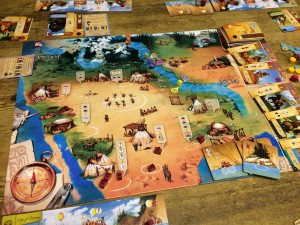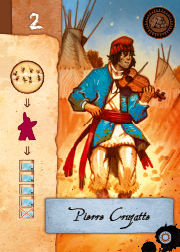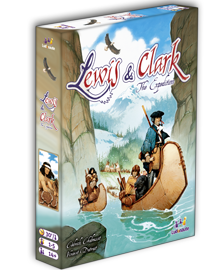Review: Lewis & Clark
Posted by James (admin) on June 12th, 2014
 Lewis & Clark is a game about the famous explorers’ journey across North America and the players race along the route from St Louis to Fort Clatsop (on the Pacific coast) which is a sequence of river and mountain spaces. The winner is the first player to make camp at Fort Clatsop.
Lewis & Clark is a game about the famous explorers’ journey across North America and the players race along the route from St Louis to Fort Clatsop (on the Pacific coast) which is a sequence of river and mountain spaces. The winner is the first player to make camp at Fort Clatsop.
Players have characters (cards) and Indians (meeple) which they use to take actions which earn resources and, ultimately, advance their scout. Each player starts with a board showing several boats (and they can gain more) which is where they store their resources and Indians. The boats limit how much a player can carry but they have another important role/effect too when it comes to making camp.
Making Camp
On their turn, a player can ‘make camp’ which moves their camp marker to where their scout is, plus they pick-up all their played cards back into their hand. However, before placing the camp marker, the scout must first move backwards a number of spaces based on how many unplayed cards the player has, plus the resources/Indians in their boats. Each boat specifically carries resources or Indians – some carry items without penalty, some have a flat rate cost regardless of contents, and some have a penalty for every item in the boat.
As a result, Lewis & Clark is one of the few (only?) games I can think of where having too many resources can be as bad as having too few, especially as you can’t willingly discard resources. In most games, gaining lots of resources is a positive feeling, but in Lewis & Clark you’re always nervous you’ve been too greedy at the same time as being nervous you don’t have enough. It adds a very interesting extra layer to your decisions so that you take actions which will also allow you to make camp without your scout losing ground. However, taking the pain/penalty to get all your cards back can be better than spending precious actions gaining little.
Taking Actions
During the game, players take turns performing one action either by using a card from their hand, or by placing an Indian onto the board to use an action in the Indian village. Actions allow players to gain resources, turn resources into other items, move their scout, etc.

Using Character Cards for an Action
Each character card is double-sided – one side shows the action, the other their strength (1, 2 or 3). When a card is played to perform its action, it must be accompanied with either another card and/or Indians (each strength 1) to determine its total strength (max. 3) and this strength is how many times the action can be performed.
This game mechanic creates some interesting and difficult choices because you must not only think about which combination of actions you want to perform (and in which order), but also how you will ‘power’ these actions – which usually means using a card for strength making that card’s action being unavailable until you’ve camped. It is tempting to use Indians as strength on cards and these can be used again after you’ve camped; however, Indians in boats often result in moving your scout backwards.
When using a card to gain resources, the maximum number gained is based on the cards you and your neighbouring players have in front of them (as each card shows one of the resource types). Therefore, you need to consider what other players are likely to do if you’re relying on their cards to increase the resources you’ll take because they may make camp, pick up their played cards leaving you without the means to gain the resources you planned on.
Using Indians for an Action
Indians can be placed in village areas to use specific actions such as gaining canoes/horses which are essential for scout movement (unless you can gain cards that can create them or move your scout). Indians used this way are no longer yours. This adds a worker placement element to the game, especially as some actions can be unavailable because other players used them. Each player has only one card that allows them to gather Indians (taken from those currently in the village). So, you need to time when you gain Indians but also when you use them because they become available for other players. Therefore, you should consider what your opponents may do, or want to do, so they don’t upset your plans (and so you can upset theirs).

Gaining Cards
Once per turn, a player can recruit a new character (card) by spending fur and equipment. Cards all have different actions – some are better versions of starting actions, some move scouts via different means, etc. With over 50 cards, there’s a lot of variety. You have a better chance of winning with a mix cards that compliment each other, i.e. one that turns grey resource into horses with another that uses horses for both mountain and river movement. With other players buying cards, and the constant cycle of those available, gaining the cards you want is not always easy.
My advice is make sure you gain one or two cards with 3 strength on them as using the same action multiple times is really useful – you could use Indians to do that too but they stay with you when making camp so can hinder you, and can be used elsewhere.
Player Interaction
Whilst interaction is indirect, other players can affect you by picking up their cards (potentially reducing your resources gains), taking Indians, blocking village actions. Even opponent scout movement can affect you as they can not share spaces meaning you can gain a vital extra space by landing on one and sliding forwards (although this also happens when going backwards).
Scout Movement
Gaining resources and using actions to move your scout is one thing, but you also need to move it in sync with the river and mountain spaces as these usually require different types of resources and/or actions. This means it can be really annoying if your scout slips back 1 space from where river changes to mountains before making camp, because now they need to do another river movement before a mountain movement.
 Overall Thoughts
Overall Thoughts
The game mechanics in Lewis & Clark are simple, but there are several layers/systems which are quite interwoven. As mentioned above, this means lots of different decisions are required which makes the game a lot of fun and a good challenge. Whilst you can get yourself in a mess by having too many, too few, or simply the wrong, resources (or if someone gets in your way), you usually feel you have a fresh chance at progress once you make camp and have all your cards back in your hand. So, you definitely need to have a plan but will often need to adjust it as you go too.
The variety of actions, the choice of which cards to use for actions or power, the order in which you take actions, and gathering enough of the right (but not too many) resources means you must have a plan. There are lots of potential options you can take and obtaining cards that work well together is very important, as is good timing.
Personally, I prefer playing with fewer players because less changes on the board between your turns so you have more control. The game plays well as a 2-player game too – resources are less plentiful (as you’ve only got one other player with cards that show resource icons) but this is the same for both players.
The game can be played solo which is a race against a scout that simply moves one step along the route after every one of your actions. (Extra resource icons are available depending on which village actions are occupied.) I enjoyed playing it solo as the decision-making and planning were all still required.
In terms of replay, variety is added by which character cards are available for purchase and when (with many not appearing because there are lots of them). In addition, the game comes with some river and mountain markers so you can alter the scouts’ route – I really like this addition as it is simple but adds good variety.
Physically, the game is great. The artwork is really nice and colourful, the board looks excellent and the wooden hexagon resources are solid and work really well. Each card/image represents a historic figure too and the rules describe some background on each one. I really like the theme too.
So, what don’t I like about Lewis & Clark? To be honest, not much. If you make mistakes, or get screwed over by another player (albeit inadvertently – or so they’ll have you believe), you will pay the price; however, having all your cards after camping gives you fresh options. Also, a few of the cards seem more powerful than others – for example, one card allows you to use any other player’s already-played action which is powerful but is also strength 3. I think there may be a few cards that I’ll remove from games to make them more fair, or adjust their strength.
Like many people, I am surprised Lewis & Clark wasn’t at least in the SdJ Kennerspiel recommendations as I think it could easily have been one of the actual nominations.
You can read the rules on Ludonaute’s web site: bga.me/lc
James.
[Played with 1, 2, 4 and 5 players)



June 14th, 2014 at 8:42 pm
I’ve only gotten to play this once, but I really liked it. I played with five players, which is probably not the greatest number to play with when all but one person are new. I love the way deck-building was used in a way that the usual luck of the mechanism was taken away, and I really like the worker placement aspects. Thanks for the review!
June 15th, 2014 at 7:30 pm
Hi,
Thanks. I played it once with 5 and it’s quite brutal just because so much changes between turns making it hard to plan in a game that requires planing. I also found there were a lot of scouts that you might or might not land on (moving you along the route for free) but these changed a lot too so you could end up moving further (or not as far) as you thought and be left holding completely the wrong resources for your new position. Still, it was still enjoyable with 5.
I agree about the deck-building element. Rokoko does the same kind of thing where you add cards to your deck, which get cycled through, but you choose which to use (although in Rokoko you choose 3 to use for the next turn). Like you say, it removes the random element which is much better.
Cheers,
James.
July 28th, 2014 at 5:22 pm
I found your review when looking for one to refresh my memory of how to play. I got one of the first print copies, played it, loved it but moved on to other new goodies. I pulled it out again and realized I forgot a lot of things – your review is better than the rulebook which is usually the case. You have a great method for explaining complex games.
I do remember knowing before my first game that it can run long, maybe too long. To try out the game we started ahead of the start space – either on spot 6, 7 or 8. I think it was 8. We found the length and pace of the game perfect so we kept it that way and would probably not start from the beginning. That would be my advice to new players, but for us it’s the only way we’ll play. Looking forward to trying it again. Thanks for your review!
August 1st, 2014 at 6:40 pm
Hi Jacob,
Thanks for your comments. I’m really pleased my descriptions were helpful. Explaining how a game is played always takes me a long time to write but I feel it’s hard to describe what does and doesn’t work in a game without someone knowing how it plays.
A shorter track is certainly a good way to have a shorter game. Have you used the small markers that alter the spaces along the track, i.e. turns mountain spaces into river spaces, and vice versa?
Cheers,
James.
August 2nd, 2014 at 8:44 pm
Uh, what? There are small markers that alter the spaces along the track? I don’t know what you are talking about, but now I have to find out! I hope this isn’t a discrepancy between the first and second printings. Thanks!
August 3rd, 2014 at 12:26 am
Ah, I assumed they were in every game. Maybe they were a Spiel freebie? (I assume mine is first printing.) They’re individual tokens you can lay on any of the spaces of the river/mountain track. You could use anything to mark the changes. (There aren’t any rules on how to place them – you can simply make up your own mixture of spaces.)
Cheers,
James.